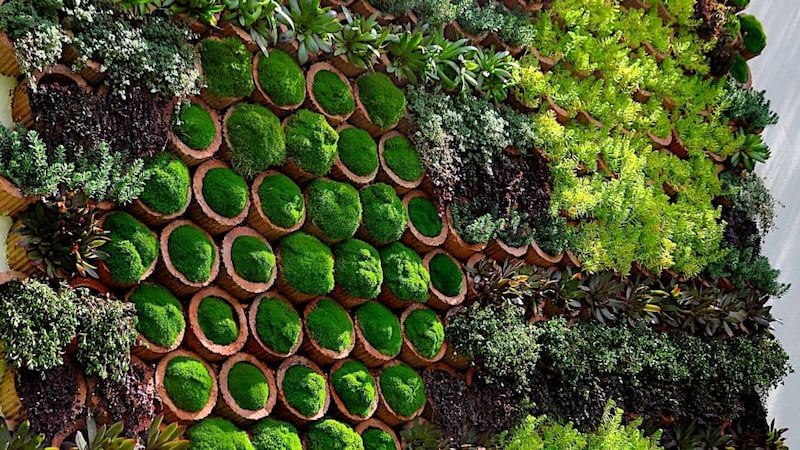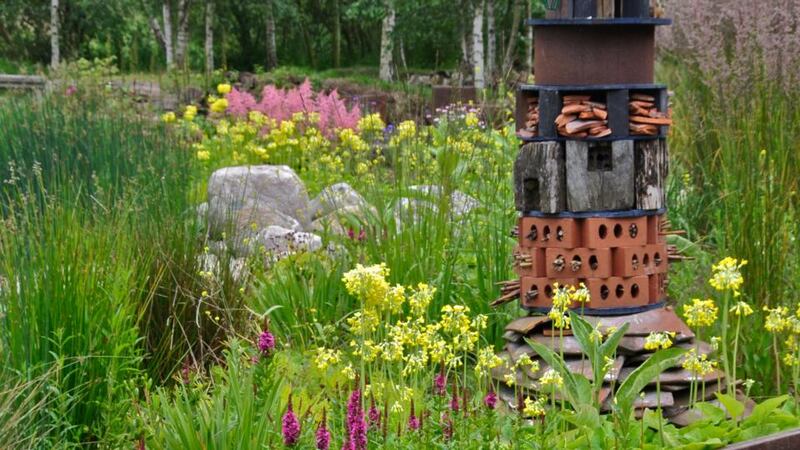Rain. It’s every Irish person’s birthright, as familiar to us as blazing sunshine to a Californian, or snow to an Inuit. As I write, I’m listening to the familiar sound of its watery rattle on the window panes, and the far-off splash of a car passing cautiously along the flooded country road outside. According to statistics, wet days in this country average between 150 and 225 annually; driest along the east and southeast coasts, wettest in the west.
In other words, some of us spend almost two-thirds of each year listening to its steady drip, drip, drip. If you think that tells a soggy story, then you won’t be cheered by research carried out by Met Éireann, which concludes that average national rainfall amounts in Ireland have increased by 70mm over the last 30 years.
The result, unsurprisingly, is that Irish gardeners’ relationship with the wet stuff is an intimate but uneasy one. We depend on it as a precious resource yet too often build houses and gardens with lots of hard, impermeable surfaces that contribute to the problems of flash flooding and water pollution while providing little in the way of wildlife habitats. And even when we do take a more progressive approach to rainwater management, it’s not always with aesthetics uppermost in mind.


And yet imagine, just for a moment, an Ireland whose towns and city skylines aren’t covered with concrete and roof tiles, but instead filled with densely planted, wildlife-friendly rooftop gardens in which bees and butterflies feed from nectar-rich flowers and birds build nests in trees growing high above the busy streets. Better still, imagine that such gardens have been designed to be beautiful as well as offer a solution to the problems of water, noise and soil pollution and urban flooding - as have their ground-level counterparts. If all that sounds intriguing, then you’ll surely enjoy the much-anticipated talk by the award-winning English garden designer and author Prof Dunnett, which he’ll be giving at the National Botanic Gardens in Glasnevin, Dublin later this month at the invitation of The Irish Garden Plant Society.
When he’s not designing innovative gardens, writing books, or travelling the world giving talks, Dunnett is kept busy by his job as lecturer at the University of Sheffield in South Yorkshire – a university that has so distinguished itself in the field of progressive, ecologically attuned, urban landscape design that the pioneering work of its key practitioners (most notably Dunnett and his colleague Prof James Hitchmough) is often referred to as the Sheffield School.
Dunnett specialises in the design of gardens that are aesthetically satisfying and ecologically sustainable, as seen most recently in his gold-medal winning show garden for this year’s Chelsea Flower Show.
This featured a leafy urban rooftop with its very own rain-fed wetland (a first for Chelsea) through which a timber boardwalk gently wended its way, leading visitors past different flower-rich planting zones and towards a garden pavilion. The latter was capped with a green roof and cloaked in sculptural “habitat panels”, all with the aim of encouraging as wide a range of garden wildlife as possible to take up residence.
For Dunnett, it was an opportunity to showcase the fact that “rain gardens offer such huge opportunities to do things with plants that you’d never be able to do in a more conventionally-designed garden. Rather than just being spaces in which to sit and enjoy a barbeque, they are multi-layered”. Such gardens, he says, serve many functions, not only reducing the amount of storm water reaching the ground by as much as 90 per cent, but also providing peaceful, wildlife friendly retreats in the heart of our concrete jungles. “Our cities need to become greener – rain gardens that use richly dynamic planting are one of the ways to do this.”
Of the many that he’s designed, Dunnett’s especially proud of the London Wetland Centre, which opened to the public in 2010. Another recent project – the “Diamond Garden” just outside Buckingham Palace – is, he says, “really significant, in that it shows how environmental challenges, in this case the problem of urban flooding, can be overcome in a way that results in an exciting garden being created in a public space”.
But it’s not just his work in the area of rain gardens and green roof design that has brought Dunnett into the public eye. In fact he’s probably best known for the extraordinarily beautiful and intensely colourful “pictorial meadows” that were such a distinctive feature of the London Olympic Park (now in transition to what will become known as the Queen Elizabeth Park), where he and Hitchmough acted as the principal planting design and horticultural consultants. Remarkably, these meadows were all grown from seed directly sown on site using different mixes of either annual or perennial plants, each carefully calibrated to give a range of long-lasting, colour-themed floral displays that left the visiting public utterly entranced. One example is the “Grandstand Annual Mix”, a fiery combination of Black-Eyed Susan, Red Orache, Larkspur and frothy Ammi majus. “The Olympic Park meadows provoked an amazing, often very emotional response from people, while sales of the meadow seed mixes quadrupled almost overnight.”
Dunnett and Hitchmough’s dramatically colourful, wildlife-friendly pictorial meadows provide exciting alternatives both to conventional flower borders as well as the more traditional wildflower meadows that depend on the skilful nurturing of native species (predominantly grasses) and a carefully timed cutting regime. “We aren’t trying to recreate something that you might see in the countryside, but to design something that’s very visually dynamic, floriferous and long-flowering yet cost-effective and low-maintenance, using directly-sown, naturalistic plant communities ecologically suited to the particular conditions of the site.”
Already, these meadows are being used to dramatic effect across the UK and Ireland, where they’re beginning to transform not only public landscapes but also private gardens. Just like the rain gardens and the green roofs that Dunnett creates, they’re proof that the very best sort of planting combines a deep understanding of ecology with an artist’s eye for design.
Nigel Dunnett give his talk in the National Botanic Gardens, Glasnevin, on November 28th at 8pm. See irishgardenplantsociety.com for details. For more information on Prof Dunnett’s work, green roof technology and pictorial meadows, see nigeldunnett.info, thegreenroofcentre.co.uk and pictorialmeadowmixes.co.uk.











